EvangelineTrail
The Evangeline trail is a signposted route that takes you along the coast of the Bay of Fundy ending at Yarmouth. While this coast has fewer fjords and headlands than the south eastern coast, it still has a lot to offer. In addition to the huge tidal range found at the north eastern end of the Bay of Fundy there is a great deal of history to be found along the trail. It was along this coast that the first French settlement was built and the British soon followed them. When in 1713 French Acadia became British Nova Scotia , the Acadians were not loyal subjects so the British expelled many of them. Some settled in Louisiana, where the Acadians became known as "Cajuns" and were immortalised in Longfellow's poem Evangeline.
Historic Gardens, Annapolis Royal
The Historic Gardens in Annapolis Royal are actually relatively modern. They were built in the early 1980s in order to promote the history and cultural heritage of Annapolis Royal. The gardens have been laid out as a series of themed gardens representing different periods in local history. The name ‘Historic Gardens’ is a reference to the fact that the early French settlers drained the land on which the town of Annapolis Royal now stands and began a distinctive form of dykeland agriculture that is still in use today.
Fort Anne, Annapolis Royal
This is an area where the battle for control between France and Britain is writ large. Charles Fort was built on this site by Scottish settlers in 1629, but France won control of the area in the 1630s and they made Port Royal, as they called it, capital of the French colony of Acadia. In 1710 British and New England troops took Port Royal. When the 1713 Treaty of Utrecht gave this area to Britain, the town was renamed Annapolis Royal and it became the first capital of Nova Scotia. The fort was named Fort Anne in the 19th century. Today the fort consists mainly of earthworks overlooking the Annapolis Basin, but the former Officers’ Quarters have been converted into a museum. Click Tab 2 to see a view of the Annapolis Basin from Fort Anne.
O'Dell House Museum, Annapolis Royal
Located on the waterfront at Annapolis Royal is a former stage coach inn and tavern built around 1869. It has been named after Nova Scotia Pony Express rider Corey O'Dell. The Nova Scotia Pony Express was set up in 1849 to carry news between New York and Europe. New York was linked to St John, New Brunswick by telegraph, then fast boats carried the news across the Bay of Fundy. The Pony express took the news on to Halifax, where Cunard steam packets took it on to Liverpool. The Pony Express was short lived and O’Dell became an innkeeper. He and his family lived in this building which has now been preserved as a museum of life in the Victorian era. The building also houses the Annapolis Heritage Society's Genealogy Centre.
Bear River
If you have visited Alaska then the houses on stilts at Bear River will be no surprise. Although the tidal range decreases as you move towards the mouth of the Bay of Fundy, the range here is still around 7 metres (23 feet). The town was established in 1783 by German mercenaries and loyalists who left the American Colonies following the revolution. It soon became a centre for the timber trade and ship building. Nowadays Bear River attracts artists and is a centre for tourists.
Eglise St Alphonse, St Alphonse
Fearing that Acadians were not loyal, the British expelled them from Nova Scotia between 1755 and 1763. Many went to France and some others went to Louisiana (then Spanish territory) to found the Cajun (Acadian) traditions there. Later some Acadians were allowed back, and they set up fishing communities on the coast. The District of Clare between St Bernard and Cape St Mary is one area where the returning Acadians settled. St Alphonse is known for its Parish Church, which has hand-painted murals behind the sanctuary and the grotto in the corner that has miraculous water running through it
Port-Royal
Although it is thought that John Cabot (an Italian leading an English sponsored expedition) first landed in Nova Scotia at Cape Breton in 1497, it was the French who first settled in the area. Port-Royal was established in 1605 by Samuel de Champlain and François Pont-Gravé as a fur trading centre. The settlement had a fairly short life as an English invasion force burned it to the ground in 1613 and in 1614 the remaining settlers returned to France. In 1939-41 plans found in France were used to build a replica on the original site near Annapolis Royal. The habitation is small and you can understand how vulnerable the early settlers must have felt. Click on Tab 2 for a view of the interior of the habitation.
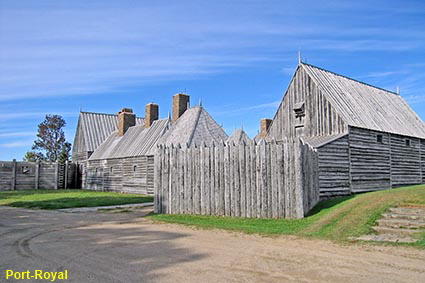
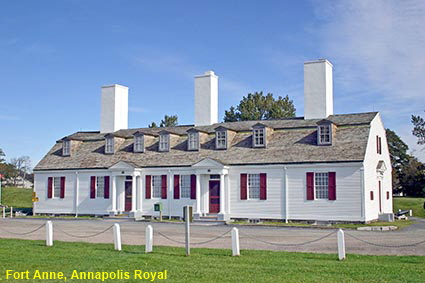
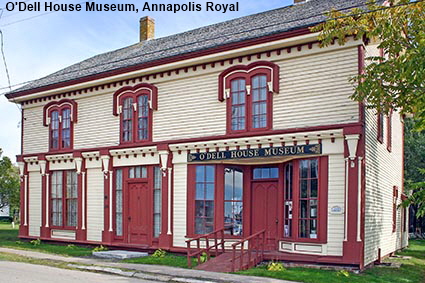
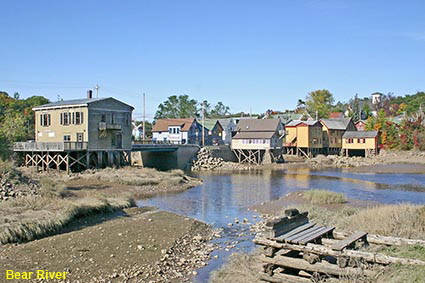
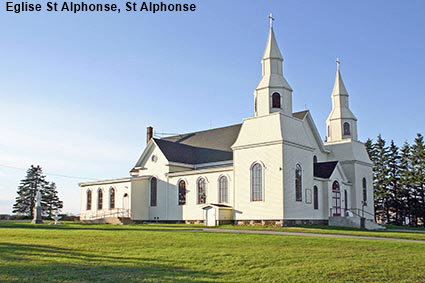
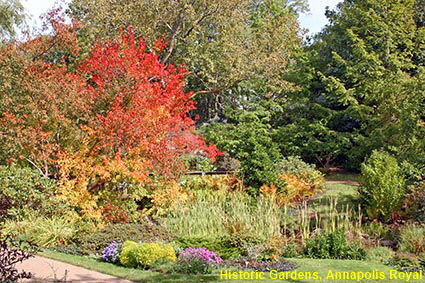
Home > Oh! Canada > Maritime Provinces > Nova Scotia >
Click on Minimap to navigate


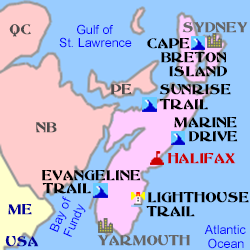
To move forwards or backwards through the Nova Scotia trail click the arrows above, or select your next destination on the Minimap.
DLU060525

© Mike Elsden 1981 - 2023
The contents of this page may not be reproduced in full or in part without permission